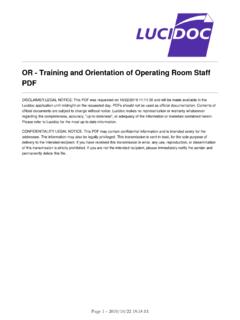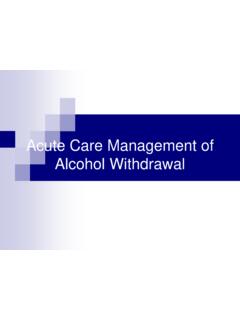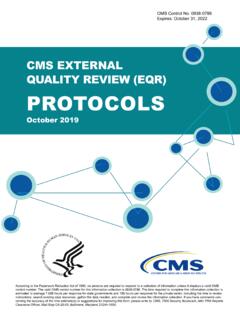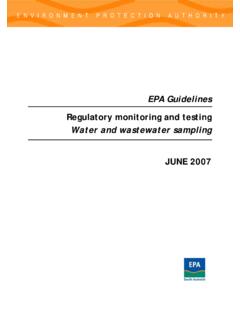Transcription of STERILE DRAPING FUNDAMENTAL PRACTICES
1 STERILEDRAPING: FUNDAMENTALPRACTICES19631963 STERILEDRAPING: FUNDAMENTALPRACTICESSTUDY GUIDED isclaimerAORN and its logo are registered trademarks of AORN, Inc. AORN does not endorse any commercial company s products orservices. Although all commercial products in this course are expected to conform to professional medical/nursing standards,inclusion in this course does not constitute a guarantee or endorsement by AORN of the quality or value of such products or ofthe claims made by the responsibility is assumed by AORN, Inc, for any injury and/or damage to persons or property as a matter of product liability,negligence or otherwise, or from any use or operation of any standards, recommended PRACTICES , methods , products.
2 Instructions,or ideas contained in the material herein. Because of rapid advances in the health care sciences in particular, independentverification of diagnoses, medication dosages, and individualized care and treatment should be made. The material containedherein is not intended to be a substitute for the exercise of professional medical or nursing content in this publication is provided on an as is basis. TO THE FULLEST EXTENT PERMITTED BY LAW, AORN,INC, DISCLAIMS ALL WARRANTIES, EITHER EXPRESS OR IMPLIED, STATUTORY OR OTHERWISE, INCLUDINGBUT NOT LIMITED TO THE IMPLIED WARRANTIES OF MERCHANTABILITY, NONINFRINGEMENT OF THIRD-PARTIES RIGHTS, AND FITNESS FOR A PARTICULAR publication may be photocopied for noncommercial purposes of scientific use or educational advancement.
3 The followingcredit line must appear on the front page of the photocopied document:Reprinted with permission from The Association of periOperative Registered Nurses, DRAPING : FUNDAMENTAL PRACTICESC opyright 2013 AORN, Inc. All rights reserved by AORN, South Parker Road, Suite 400 Denver, CO 80231-5711 (800) 755-2676 produced by Cine-Med, Inc127 Main Street NorthWoodbury, CT 06798 Tel (203) 263-0006 Fax (203) 263-4839 DRAPING PRINCIPLES OF DRAPES TO ESTABLISH A STERILE FOR SPECIFIC OPERATIVE and Face POST-TEST : FUNDAMENTALPRACTICESS terile DRAPING : FUNDAMENTAL PracticesTABLE OF CONTENTS3 STERILEDRAPING.
4 FUNDAMENTALPRACTICESPURPOSE/GOALThe purpose of this study guide and companion video is to review techniques for STERILE DRAPING , which is a FUNDAMENTAL aspectof STERILE viewing the video and completing the study guide, the participant will be able to:1. Explain the rationale for using STERILE drapes to establish the STERILE field. 2. Describe methods to drape equipment located next to or within the STERILE Discuss basic techniques for DRAPING Identify proper ways to drape patients for four types of surgical : FUNDAMENTALPRACTICESOVERVIEWThis study guide reviews concepts and PRACTICES related tosterile surgical drapes and DRAPING , which are fundamentalcomponents of STERILE technique.
5 Surgical drapes are used to create a STERILE field around thesurgical site and establish a physical barrier that reduces therisk of surgical site infections (SSIs) by decreasing themovement of microorganisms from unsterile to STERILE recommends that perioperative team members usesterile surgical drapes on the patient, OR furniture, andequipment that are to be included in the STERILE field, and thatpersonnel handle surgical drapes in ways that selection and correct use of STERILE surgical drapes areessential PRACTICES for establishing and maintaining a sterilefield.
6 STERILE drapes must be handled properly to optimize theirfunction and prevent contamination. They must also be placedcorrectly depending on the invasive procedure to beperformed. This guide first reviews basic principles of drape selection anduse, and then describes proper DRAPING methods forlaparotomy, extremity surgery, lithotomy, and surgeriesrequiring facial exposure and robotic REVIEWS tandards for surgical drapes have evolved over time asresearchers have studied and improved the physical barrierfunction of DRAPING woven fabrics have been used to protect the surgicalsite since the turn of the last , the mostfrequently used material for DRAPING was muslin.
7 A looselywoven cotton fabric; however, muslin was later observed tolose its barrier efficacy when wet. Because of this, muslineventually was replaced with other woven, reusable materialsand with nonwoven, single-use disposable surgical textile industry later began developing limitedperformance standards and methods to test products for barrierefficacy; however, manufacturers did not adapt or followconsistent protocols for these PRACTICES . Reusable drapes, inparticular, were tested with a variety of methods .
8 Theseinconsistencies made it difficult to compare the quality andperformance of different products. In addition, as recently asthe 1980s, there were no standards for flammability or fibercontent, and numerous woven and nonwoven materialsremained on the , these problems have drawn additional scrutinybecause of increasing rates of bloodborne pathogen infections can be transmitted during surgery and otherinvasive procedures when products fail during surgery orwhen appropriate infection-prevention guidelines are American National Standards Institute.
9 And theAssociation for the Advancement of Medical Instrumentationhave published a common system for classifying drapes andprotective apparel used in health care facilities, and have alsopublished labeling requirements for these is based on standardized testing that assesses liquidbarrier performance. The AORN recommendations emphasizethe importance of consistent classification and labeling ofsurgical drapes by DRAPING MATERIALSS electing appropriate, high-quality DRAPING materials is animportant step in protecting patients from surgical-site andother health-care-associated factors meritconsideration during this should be intact and of sufficient quality to withstandexposure to blood, body fluids, and other potentially infectiousmaterials, as well as other liquids, rips, and abrasions.
10 Drapeswith holes, wear, or tears can allow microorganisms to passthrough, increasing the risk of surgical site and other health-care-associated infections. In addition, the wicking of liquid5 STERILEDRAPING: FUNDAMENTALPRACTICES6through a surgical drape can facilitate the passage of pressure or stretching on a drape can also facilitatemicrobial transfer, if the force applied to the drape exceedsthe material s inherent these reasons, perioperative personnel should select drapeproducts that are as resistant to penetration by blood, otherbody fluids, and tear force from hands and surgicalinstruments, as necessary, based on the specifics of theinvasive procedure for which drapes will be used.



